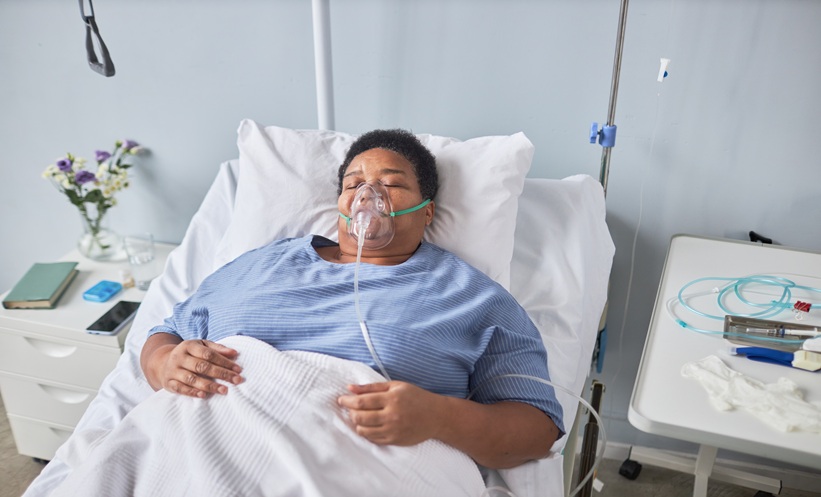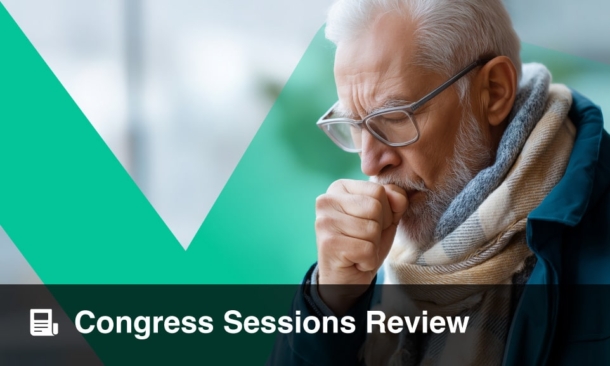Meeting Summary
This article reviews an industry symposium held on 8 September 2024 as part of the European Respiratory Society (ERS) Congress 2024 in Vienna, Austria, which brought together four experts to discuss the current treatment paradigm for severe eosinophilic asthma (SEA), including the role of biologics and background medication tapering. Katrin Milger-Kneidinger, Professor of Respiratory Medicine at the University Hospital of the Ludwig Maximilian University Munich (LMU), in Germany, and the MedUni Graz, in Austria, explored the critical role eosinophils play in SEA pathology and how biologic therapies targeting eosinophils can address key disease features, including airway remodelling, airway hyperresponsiveness (AHR), and mucus production. Felix Herth, Professor of Pulmonary and Critical Care Medicine at Thoraxklinik Heidelberg, Heidelberg University Hospital, in Germany, discussed persistent airflow obstruction (PAO) in patients with SEA, focusing on a typical patient profile to understand the clinical manifestation and opportunities for management. Stephanie Korn, Professor of Pulmonary and Respiratory Medicine at Thoraxklinik Heidelberg, Heidelberg University Hospital, in Germany, and Head of the Clinical Research Centre, Institute für Klinische Forschung (IKP) Pneumologie in Mainz, Germany, presented on remission as a clinical target in SEA, focusing on how biologics can help achieve remission in some patients. Lastly, in a discussion led by symposium chair Stefano Del Giacco, Professor of Medicine, Allergy, and Clinical Immunology, at the University of Cagliari, Sardinia, in Italy, the experts agreed that a positive practice change would be to get more patients with relevant clinical manifestations on biologics, and that background medication tapering, when appropriate, could lead to improved patient outcomes and quality of life (QoL) in SEA.
Introduction
Asthma affects approximately 262 million people globally,1 with the number of asthma incidents having increased by around 15% over the last 29 years.2 Up to 10% of this population has severe asthma,3 which accounts for an estimated 50% of all asthma-related annual healthcare costs in Europe, accounted for by an increased hospitalisation rate.4,5 Of those with severe asthma, 84% of patients are likely to have an eosinophilic phenotype, termed SEA.6 Greater patient hospital costs are associated with patients with eosinophilic asthma versus other types of asthma.7 Clinically, eosinophilic asthma is associated with more frequent and severe exacerbations (two or more exacerbations annually), poor asthma control,8 with an increased risk of asthma-related hospitalisations, and poor QoL,7 reduced lung function (evidenced by low forced expiratory volume in 1 second [FEV1] and persistent airflow limitation),9–11 a higher likelihood of nasal polyps, asthma being adult-onset,6 steroid dependence,10 and death.10,12
Historically, the use of oral corticosteroids (OCS) has been common practice in treating severe asthma,13 but long-term use of OCS carries significant health risks for patients with severe asthma.14 With these challenges in mind, the overarching aim of this symposium was to advance clinical practice in SEA and reduce the global burden of long-term background medications in partnership with healthcare professionals (HCP).
Latest Advances in Understanding the Critical Role of Eosinophils in Severe Asthma: A Key Driver of the Hallmarks of Disease
Katrin Milger-Kneidinger
Milger-Kneidinger shared the up-to-date evidence demonstrating the critical role of eosinophils in driving the key features of SEA, including remodelling, mucus plugging, and AHR.
Notably, the airway pathology of SEA is characterised by Type 2 eosinophil-rich airway inflammation which causes epithelial damage and drives airway remodelling.15,16 Processes involved include goblet cell hyperplasia, mucus production, and smooth muscle contractility and hypertrophy.15,16 Clinically, this manifests in bringing about exacerbations, airway obstruction, clinical symptoms, and AHR.15,16 As such, elevated eosinophils remain one of the most important targets for SEA.
Targeting the IL-5 Pathway
Mitigating the cytotoxic effects of eosinophils by reducing systemic levels is a key treatment strategy in SEA.17–20 Milger-Kneidinger highlighted that monoclonal antibodies targeting the IL-5 pathway are key to reducing eosinophil levels in those with asthma, through either binding with IL-5, such as mepolizumab and reslizumab, or interacting with the IL-5 receptor, such as with benralizumab.18,21 Milger-Kneidinger summarised data which indicate that benralizumab achieves a substantial eosinophil reduction, with ≥95% reduction in blood and sputum eosinophils, and 80–94% in the airway.18 Mepolizumab has demonstrated an 80–94% reduction in blood eosinophils but <50% in sputum, and reslizumab demonstrated an 80–94% reduction in blood eosinophils and 50–79% in sputum.18 According to Milger-Kneidinger, the importance of reducing eosinophils in the airway with IL-5 antibodies, stating “improvement in clinical symptoms has been observed; however, some patients may have an incomplete response, with exacerbations.” She highlighted findings from the MEX study, a UK-based multicentre, prospective observational study that investigated why exacerbations still occur in those treated with mepolizumab.19 The study found that ~50% of exacerbations on mepolizumab occur in the context of ongoing airway eosinophilia, as seen by the sputum eosinophilia and fractional exhaled nitric oxide (FeNO) levels at the time of exacerbation.19
There is a complex interplay between airway inflammation, airway remodelling, and structural changes in SEA.22–24 In the context of airway inflammation, the severity of AHR correlates with eosinophil and mast cell numbers, though AHR can also occur independently of airway inflammation.25,26 On AHR association with airway remodelling and structural changes, Milger-Kneidinger said that it is an area of evolving research, noting “especially smooth muscle hypertrophy” as a contributor, and that “bronchoconstriction itself may lead to epithelial damage and inflammation, providing another important link in this complex interplay.”
Mucus production and mucus plugs, which likely contribute to persistent or fixed airway obstruction, are also potential features in SEA.27,28 Milger-Kneidinger reported that eosinophil peroxidase degranulation by eosinophils leads to mucin crosslinking, increasing its viscosity and forming mucus plugs.27,28 Higher levels of sputum eosinophils are associated with higher mucus scores, and higher levels of mucus plugs are associated with airway obstruction, as demonstrated by lower FEV1 over time,28 emphasising the role of eosinophils in this process.
Managing Mucus Plugging in Severe Asthma
When considering the treatment options for AHR, Milger-Kneidinger discussed the use of biologics and shared her experience from the German asthma network study.29,30,31
Treatment with biologics has been demonstrated to significantly attenuate airway challenge-induced AHR.30,31 Reducing eosinophil levels in the airways using biologics may also inhibit airway remodelling, reducing airway thickening.32,33 For example, mepolizumab reduces airway wall thickening by inhibiting airway remodelling markers, tenascin, lumican, and procollagen III,32 and benralizumab reduces airway smooth muscle mass by targeting IL-5 receptor-α.33
Treatment with biologics such as tezepelumab, mepolizumab, dupilumab, and benralizumab, has been linked to reductions or near-elimination of mucus plugs.34–37 Reductions in mucus plug scores are positively correlated with improved FEV1 percentage.38
Positive bronchodilator (BD) reversibility is a diagnostic criterion for asthma.31 However, as seen in the German asthma network study, two-thirds of patients exhibited a negative BD reversibility response.31 Positive BD reversibility was associated with low baseline predicted FEV1 percentage and chest tightness.31 Milger-Kneidinger shared that with regards to negative BD reversibility, rather than it being associated with chronic obstructive pulmonary disease (COPD) or smoking history, it was associated with lower FeNO and the presence of gastro-oesophageal reflux disease.31 Milger-Kneidinger then reported that treatment with anti-IL-5 or anti-IL-5R biologics can reduce OCS dependence, annualised exacerbation rates, and improve symptoms (reported with a positive change in asthma control test score) and lung function (reported by an increased FEV1) in patients with severe asthma, regardless of positive or negative BD reversibility.39 Milger-Kneidinger also reported that it may be possible to predict improvements in lung function, dependent on patient characteristics when considering the use of biologics, as a higher initial mucus plug score increased the likelihood of having improvement in FEV1 following treatment.40
Milger-Kneidinger concluded that 1) eosinophils drive asthma pathology through airway inflammation, remodelling, and structural changes; 2) thorough eosinophil depletion is key to reducing the risk of eosinophilic-associated exacerbations; and 3) reducing eosinophils in SEA reduces AHR, airway wall thickening, and mucus plug formation.
A Focus on Persistent Airflow Obstruction in Severe Eosinophilic Asthma
Felix Herth
Herth identified that the understanding of the clinical traits and pathological mechanisms for asthma is still emerging,41-44 and therefore explored the latest evidence for the role of eosinophils in individuals with SEA with PAO and reviewed typical patient profiles to understand the clinical manifestation and opportunities for management.
PAO, a clinical phenotype seen in individuals with SEA, is defined as a post-BD FEV1/FVC ratio of <0.7 and is thought to be due to airway wall remodelling.3 It may develop later in the asthma course, with Herth emphasising that some patients initially present with variable airflow obstruction.3 This phenotype is often confused with COPD.3,45
Key Risk Factors and Clinical Presentation in Developing Persistent Airflow Obstruction
Herth called for a need for improved awareness around the challenge of misdiagnosis of COPD for those that should have a diagnosis of SEA with PAO, presenting a case study of a 65-year-old female, ex-smoker with a previous diagnosis of COPD, who presented with increasing shortness of breath, cough, and exacerbations. Diagnostics demonstrated poor lung function, specifically a pre-FEV1 of 0.72 L (29.6% predicted), post-FEV1 of 0.85 L (37.1% predicted), and residual volume of 190%. However, Herth highlighted the diffusion capacity testing with transfer factor of the lung for carbon monoxide was 76.3%, suggesting that further investigation was required and indicated SEA with PAO. These diagnostic challenges are problematic as PAO in asthma can, in some cases, be reversible with appropriate treatment, as observed in the case presented by Herth.3,45
Up to 23% of those with asthma have PAO, with it being most common in those with severe disease.46 Risk factors for developing PAO include older age, male sex,47 preterm birth and low birth weight, greater infant weight gain, chronic mucus hypersecretion, longer asthma duration, lack of inhaled corticosteroid (ICS) treatment, low initial FEV1, exposure to tobacco smoke, and environmental pollutants.3
Herth noted that those with asthma and PAO tend to have more severe symptoms48 and poorer outcomes49 such as reduced lung function,50,51 increased airway inflammation,50 risk of exacerbation,50,51 and mortality,52 compared to those with asthma without PAO.3,48-52 Contributing to the differences in clinical outcomes in patients with asthma and PAO compared to those without PAO is an association with increased sputum and blood eosinophils, higher monocyte counts in the blood, fewer macrophages in sputum, and a greater decline in lung function (FEV1).50,51 As such, remodelling of the airway epithelium, likely influenced by eosinophil-driven mucus production and plugging, as eluded by Milger-Kneidinger, also contributes to the pathophysiology of PAO.53-56
Management Options for Severe Eosinophilic Asthma with/without Persistent Airflow Obstruction
Biologics have shown to be of benefit to those with SEA, regardless of PAO status. Benralizumab significantly reduced annualised exacerbation rates (AER) (44% reduction in those with PAO status, and 42% in those without PAO status) and improved pre-BD FEV1 (0.159 L increase in those with PAO status, and 0.103 L increase in those without PAO status) compared to placebo.57 Dupilumab similarly demonstrated improved AER and pre-BD FEV1 in patients with PAO and eosinophil levels of ≥150 cells/μL or FeNO at ≥25 parts per billion at baseline, and in patients with PAO and eosinophil levels of ≥300 cells/μL and FeNO at ≥25 parts per billion at baseline when compared to placebo.49 Tezepelumab and omalizumab also reduced annualised AER over 52 weeks compared to placebo in patients with and without PAO, although, as reported by Herth, a study on omalizumab has highlighted a potentially difficult-to-treat group in patients with or without PAO but low BD responsiveness.58,59
Herth emphasised that as PAO is a distinct clinical phenotype characterised by irreversible airflow obstruction, there is a need to be aware of the misdiagnosis of COPD. Herth summarised that patients with asthma and PAO generally experience worsening outcomes compared to those without PAO, and that airway remodelling plays a critical role in the development of PAO, with biologics demonstrating improved symptom control and reduced exacerbations in patients with asthma and PAO.
Remission as a Clinical Target for Severe Eosinophilic Asthma
Stephanie Korn
Stephanie Korn shifted the focus to remission as a clinical target in SEA, focusing on the value of targeting clinical remission for patients compared with traditional treatment goals.
To define remission in asthma, several components must be met. These have been adopted by other conditions with chronic inflammation, and include key components for improvements in clinical outcomes, QoL, and productivity, as well as a composite of signs, symptoms, and biomarkers of disease.60-65 Although international asthma guidelines vary slightly, they all agree that the absence of exacerbations, along with no systemic steroids for treatment, are essential for defining remission.3,66,67 Korn mentioned a need to establish consensus for defining minimal or no symptoms and lung function. Key variances across guidelines include symptoms, stable lung function, and the number of missed school/work days.3,66,67
In clinical trials, remission is typically defined using four key criteria: 1) Daily symptoms (e.g., Asthma Control Questionnaire-6 [ACQ-6] score <1.5 or ≤0.75); 2) zero asthma exacerbations 3) zero OCS use; and 4) stabilisation or improvement in lung function as indicated by pre-BD FEV1.68,69 Korn presented post-hoc analysis data from the SHAMAL trial, a trial on biologic benralizumab where patients with SEA were allowed to reduce their background medication.70,71 The majority of patients enrolled in SHAMAL achieved three- or four-components of the response endpoints with clinical remission at Week 32, with the three-component criteria excluding stable lung function.70 Four-component clinical remission was achieved less frequently than three-component clinical remission, particularly in participants with inhaled corticosteroid/formoterol (ICS/FORM) stepdown.70 As such, for patients with SEA controlled on benralizumab, achieving clinical remission after ICS/FORM reduction is feasible, although Korn highlighted that there is a need for monitoring for worsening/exacerbations during ICS/FORM dose reduction.
Real-world data from XALOC-1 and XALOC-2 also demonstrated remission rates in patients with uncontrolled SEA.72,73 In XALOC-1, 60% (n=745) and 43% (n=307) achieved two- and three-component remission at 12 months, respectively.72 The missing component for both datasets was improved or stabilised lung function, with the two-component dataset also not including asthma symptom control.72 In XALOC-2, which included analysis of the impact of BMI, the proportion of participants meeting three-component remission criteria, missing improvement or stabilisation of lung function, was 51.3% (n=76) for participants with normal BMI (<25 kg.m2) and 30.4% (n=79) for participants with obesity (BMI ≥30 kg/m2 ).73 The lower rate of clinical remission in XALOC-2 participants with obesity was largely attributed to inadequately improved symptom control, and as such, Korn highlighted a need to pay particular attention to these patients.73
Korn also discussed data from the REDES clinical trial on the impact of mepolizumab in patients with SEA, where 63% (n=260) of patients on mepolizumab achieved three-component remission, excluding lung function stabilisation or improvement from remission criteria, compared to 37% (n=260) on placebo after 1 year.74 Korn also highlighted longer-term data from the QUEST and TRAVERSE trials with dupilumab, which showed increasing rates of clinical remission over time, with 35.04% of patients with uncontrolled, moderate-to-severe, Type 2 inflammatory asthma achieving four-component remission after 1 year, which was sustained at years 1.5 (38.36%) and 2 (36.10%) (N=1,584).75 The percentage of participants who did not meet any clinical remission criteria at baseline reduced from 68.76% to 9.86%, 5.11%, and 7.84% at years 1, 1.5, and 2, respectively (N=1,584).75 At baseline, the remaining 30.88% of participants met one criterion, with this number reducing to 10.10%, 14.13%, and 12.35% at years 1, 1.5, and 2, respectively (N=1,584).75
Data from the NAVIGATOR trial on tezepelumab indicated that clinical remission could be achieved in patients with severe uncontrolled asthma, regardless of blood eosinophil levels.76 To define clinical remission, NAVIGATOR utilised strict criteria, using an ACQ-6 score of ≤0.75 and a requirement of pre-BD FEV1 of >80% or improvement in pre-BD FEV1 of >20%, as well as two additional assessments.76 One was for healthcare professional assessment of change using the Clinical Global Impression of Change (CGI-C) score, and the other was for patient assessment of severity using the Patient Global Impression of Severity (PGI-S) score.76 At Week 52, 12% of patients on tezepelumab (n=53) achieved remission, compared to 4% on placebo (n=17).76 Changing symptom control and lung function criteria to ACQ-6 score ≤1.5 and pre-BD FEV1 and/or pre-BD FEV1 baseline of ≥0.95, resulted in clinical remission for 21% and 11% of participants on tezepelumab (n=97) and placebo (n=48), respectively.76 Patients with missing data were excluded from the analysis.76
Findings from a longitudinal cohort study on severe asthma using data from 23 countries from the International Severe Asthma Registry suggested that regardless of biologic choice, patients with fewer asthma-related symptoms and lower long-term OCS use before biologic initiation, have a greater chance of achieving clinical remission.77 In the study, after 1 year of treatment, 20.3% of patients (n=1,059) with data on all four components reached four-component remission when lung function criteria were set to percent predicted FEV1 ≥80%.77 Additionally, 50.2% of patients (n=2,142) with data available reached two-component remission with no exacerbations and no long-term OCS use.77 Patients with fewer asthma-related symptoms and lower long-term OCS use before biologic initiation have a greater chance of achieving clinical remission.77
To help more patients with SEA reach remission, Korn suggested that the status quo around treatment of severe asthma should be redefined. As part of this, Korn highlighted how uncontrolled asthma negatively impacts patient QoL, with asthma symptoms limiting daily activities.78,79 Korn advocated for improving disease control with earlier intervention and suggested that a treat-to-target approach could not only slow disease progression but also prevent irreversible damage.80-82 Key takeaways from Korn were that 1) clinical remission using biologics is an achievable goal for certain patients, with Korn highlighting that this should be the treatment goal in severe asthma due to the positive impact on patient QoL,3,83 2) patients in remission are those more likely to remain in remission, indicating durability,84 and that 3) remission has a positive impact on patient outcomes and should be the clinical goal in severe asthma.83 Korn did, however, highlight the need to continue refining the definition of remission with optimised tools and patient identification.
Beyond Asthma Control and Remission: Tackling the Treatment Escalator
Stefano Del Giacco
In the final session, Del Giacco led a panel discussion focused on the potential benefits of tapering background medications in SEA. The overarching goal of the discussion was to drive positive practice change and, as such, focused on reducing the burden of background medications, particularly corticosteroids, while maintaining effective asthma control.
The panel agreed that the potential treatment goal in appropriate patients should be tapering background medication while maintaining asthma control. They highlighted key benefits, including lessening treatment burden, including reduction of corticosteroid-associated treatment side effects, reducing healthcare utilisation, and overall reducing associated costs, if implemented effectively.85 To help with this, it was noted that guidelines need to be updated with the latest clinical trial data on the use of biologics in SEA. Milger-Kneidinger and Del Giacco highlighted that while some guidelines consider this, several key guidelines are behind. Herth agreed, suggesting that reports by the Global Initiative for Asthma (GINA) are the most useful resource,3 as they are a frequently updated source of practical recommendations that can support the management of SEA and the use of biologics.
GINA shared advice regarding reduction in background therapy in those patients who have demonstrated a good asthma response to therapy that targets Type 2 inflammation, with the highest priority given on reducing and ceasing maintenance of OCS, if used.3 To guide adjustment of maintenance ICS, GINA advises regular evaluation of each severe asthma treatment, either through assessment of patient symptom control or using biomarkers such as sputum eosinophil count and FeNO.3 Addressing how this can be achieved, if not already, these practices should be incorporated into existing patient pathways. This will be important for successful implementation and adoption.
Del Giacco raised the idea of potential reservations and anxiety of patients in terms of the patient’s response to the idea of reducing background therapy. The panel agreed that patients are very receptive to this, with Milger-Kneidinger and Korn suggesting patient excitement is common. Herth added that, based on experience, those with severe asthma are usually more informed about their condition, which adds to their positive experience when suggesting the reduction of background therapy. Patients who are well-informed and understand what to expect from their asthma care have demonstrated improved outcomes and higher adherence to treatments versus those who are not.86
Herth mentioned SHAMAL71 , a randomised clinical trial where patients on benralizumab were able to reduce corticosteroid use and that it could be used as a reference for tapering. However, Herth stated that it is critical that one prioritises local prescribing, labelling, and indications when considering dose reduction of ICS. Herth also highlighted that in their experience, the dose reduction of corticosteroids is not necessarily the primary issue impacting patients with SEA; rather, the major difficulty currently faced is that a high number of patients are still not using biologics. As suggested by the panel, more data on the potential benefits of early intervention with biologics will be helpful to ensure practice change.
The major takeaway from the panel was the need to focus on patients who still have uncontrolled symptoms, especially those who are currently not on biologics. Milger-Kneidinger emphasised that patients reducing background medication should continue seeing a specialist to ensure their condition is monitored in case of worsening symptoms so that the patient does not fully stop taking medications that may be required for disease control.
Conclusion
The symposium provided valuable insights into the management of SEA, particularly focusing on the roles of eosinophils, airway remodelling, and PAO. It highlighted the critical importance of reducing eosinophils to mitigate exacerbations, improve lung function, and manage airflow limitation, alongside how biologics are currently key to helping achieve clinical remission in responsive patients. The discussion also reinforced the potential for tapering background medications, including corticosteroids, in well-controlled SEA. With these advancements, the overarching goal is to improve patient outcomes, reduce healthcare costs, and enhance the QoL in patients with SEA by refining treatment approaches and promoting earlier intervention.







